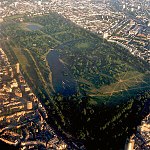world.wikisort.org - United_Kingdom
Old Oak Common is an area of Hammersmith, in the London Borough of Hammersmith and Fulham, West London.
| Old Oak Common | |
|---|---|
 Old Oak Common Railway Maintenance Depot | |
 Old Oak Common Location within Greater London | |
| Population | 9,175 |
| OS grid reference | TQ216823 |
| London borough | |
| Ceremonial county | Greater London |
| Region | |
| Country | England |
| Sovereign state | United Kingdom |
| Post town | LONDON |
| Postcode district | NW10 |
| Dialling code | 020 |
| Police | Metropolitan |
| Fire | London |
| Ambulance | London |
| UK Parliament |
|
| London Assembly |
|
Together with neighbouring Park Royal, the area is intended to become the UK's largest regeneration scheme,[1] the scale of which has led to Park Royal and Old Oak Common being described as a potential "Canary Wharf of West London".[2][3]
The area is traditionally known for its railway depots, particularly Old Oak Common TMD. Further south lies an open area, Wormwood Scrubs Park, and Wormwood Scrubs prison. Willesden Junction station lies to the north of the area. In the mid-19th century it was a centre for pig farming.
History
Originally, Old Oak Common was a stretch of land defined by what became the Harrow Road at its northern end, and its eastern edge was the northern source of Stamford Brook, forming a boundary with Wormwood Scrubs. By 1801,[4] the Paddington Canal had cut it in half, further reducing its size. With the coming of the railways, most of the common was lost and what remained became part of Wormwood Scrubs.
The Great Western Railway's Great Western Main Line (GWML) of 1838–1841 from London Paddington to Bristol and the 1903 Acton-Northolt line to the Great Western and Great Central Joint Railway at Northolt divided at Old Oak junction.
The partially singled Acton-Northolt line closed in December 2018 to allow for the construction of Old Oak Common railway station, which will offer interchange between GWML trains, the Elizabeth line and the High Speed 2 (HS2) line heading north. Additional rail interchanges may be provided with the construction of two new London Overground stations, Hythe Road on the West London line and Old Oak Common Lane on the North London line.[5][6]
In summer 2011, the London Borough of Hammersmith and Fulham launched a wide-ranging 'Park Royal City' plan for Old Oak Common, including the proposed station, and with light-rail lines to the surrounding areas.[7]
Regeneration
In December 2013, The Independent reported that Antony Spencer, founder of Stadium Capital Development, was to head up a £5 billion regeneration scheme in the area, with partner Queens Park Rangers. The proposal included new homes, office, retail outlets, and a proposed football stadium for QPR.[8] The planning application was rejected.[9]
The Old Oak and Park Royal Development Corporation was established in 2015 to lead regeneration and planning work for an area covering Old Oak Common and much of the Park Royal area. The combined redevelopment area is envisaged to provide 65,000 new jobs and 25,000 new homes.[10]
The engineering plans were revealed in 2018 showing a station at Old Oak Common for HS2, the high speed line running from London to Birmingham. Passengers using HS2 will be able to disembark at Old Oak Common and interchange with the Elizabeth line, Chiltern Railways and Great Western Railway services. The station will have a capacity for around 100 million passengers, rivalling London Waterloo in Central London.[11]
References
- "About Old Oak and Park Royal Development Corporation". Greater London Assembly.
- Prynn, Jonathan (27 January 2016). "'Famous institution' will move to Old Oak Common culture zone". www.standard.co.uk.
- Thompson, Barney (27 January 2015). "Plans to regenerate London's Old Oak Common clear hurdle".
- Paddington Canal#The branches
- "First glimpse of how two new London Overground stations could look". Evening Standard. Retrieved 20 November 2017.
- "Have your say on two potential new London Overground stations at Old Oak". TfL Consultation Hub. Retrieved 20 November 2017.
- "Launch of 'Park Royal City'". London Borough of Hammersmith & Fulham. Archived from the original on 17 October 2011. Retrieved 14 October 2011.
- "QPR: Club announce 'exciting' plans for a new 40,000-seat stadium in". The Independent. 14 December 2013.
- "London regeneration: Old Oak Common, a scheme in trouble?". Property Investor Today. 11 September 2019. Retrieved 25 April 2022.
- "Vision for the area". From GLA website.
- Smale, Katherine (3 April 2018). "Engineering plans for HS2 Old Oak Common station revealed".
Другой контент может иметь иную лицензию. Перед использованием материалов сайта WikiSort.org внимательно изучите правила лицензирования конкретных элементов наполнения сайта.
WikiSort.org - проект по пересортировке и дополнению контента Википедии


